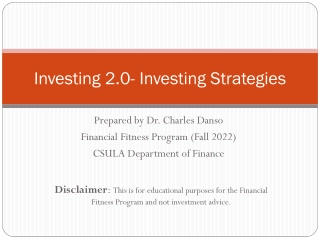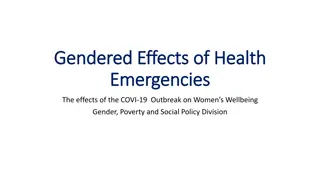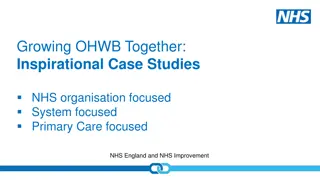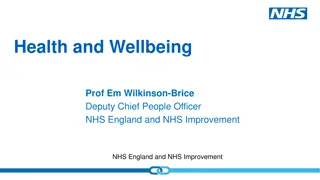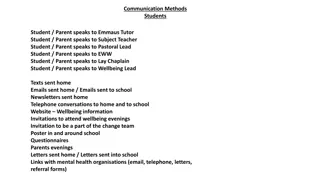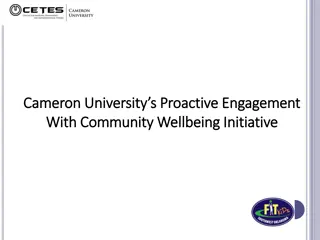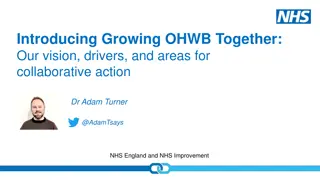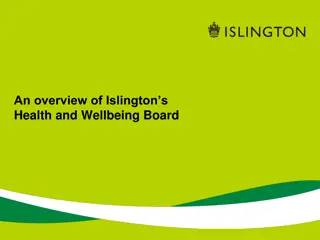
Investing in Health and Wellbeing at Work - The Business Case Analysis
Learn about the critical importance of investing in health and wellbeing at work for businesses, with insights on costs of absence, presenteeism, and turnover. Explore strategies and activities that can enhance productivity, creativity, and overall employee satisfaction. Discover the benefits of integrated provision and various interventions to promote mental health and wellbeing in the workplace.
Download Presentation

Please find below an Image/Link to download the presentation.
The content on the website is provided AS IS for your information and personal use only. It may not be sold, licensed, or shared on other websites without obtaining consent from the author. If you encounter any issues during the download, it is possible that the publisher has removed the file from their server.
You are allowed to download the files provided on this website for personal or commercial use, subject to the condition that they are used lawfully. All files are the property of their respective owners.
The content on the website is provided AS IS for your information and personal use only. It may not be sold, licensed, or shared on other websites without obtaining consent from the author.
E N D
Presentation Transcript
The business case for investing in health and wellbeing at work Professor Jo Yarker, Divija Bansal, Dr Rachel Lewis
The business case for investing in health and wellbeing at work The business case for investing in health and wellbeing at work Why health and wellbeing is a business Why health and wellbeing is a business- -critical issue Annual costs of absence, presenteeism, and turnover reached 53-56 billion in 2020-21 (Deloitte, 2022). Stress is one of the main causes of absence, and high workloads are the main cause of stress-related absence (CIPD, 2023). Estimated gains from improved productivity, attraction and retention could be around 120- 220 bn per year or over 4000-7000 per employee (BITC, 2023). When employees are thriving, they feel 84% more productive and 79% more creative (BITC and YouGov, 2022). critical issue: : Why integrated provision is vital Why integrated provision is vital Integrated provision includes co-ordinated and tailored suite of activities at each of the levels of intervention Positive work experiences lead to better overall health (encompassing physical, mental, social and spiritual health), greater innovation at work, and improved job performance (McKinsey Health Institute, 2023). Multifaceted interventions that balance work demands and provide job resources on the organisational, team, job, and individual levels enhances health (McKinsey Health Institute, 2023). Business Case Business Case Level of Intervention Level of Intervention Example Activities Example Activities ROI of 5.6 for every 1 invested (Deloitte, 2022). Good people management practices result in 3x higher likelihood of engagement, lower sickness absence (What Works Wellbeing, 2017). Work design strategies such as increasing worker schedule control and voice, and regulating job demands leads to increased wellbeing (Lovejoy et al., 2021). Flexible working consistently increases wellbeing outcomes (Fox et al., 2022). Participatory interventions reduce stress and empowered employees, reducing absence and improving retention (Nielsen et al., 2021). ROI of 5 for every 1 invested (Deloitte, 2022). Training and employer support aimed at enhancing social relations at work improves wellbeing (Lovejoy et al., 2021). Mental health literacy training increases knowledge and reduces stigma (Kelloway et al., 2023). Developing manager competencies to prevent and reduce stress improves job satisfaction, performance and reduces absence (Yarker& Lewis, 2022, 2024). Identifying and managing risks at source, work design, flexible working, participatory interventions, good people management practices Prevent Prevent and and protect protect Integrated provision Integrated provision Training and skill development to enhance social relations, mental health literacy, and line manager confidence and competence Promote Promote and and develop develop Evidence React React and and repair repair Therapy/counselling, Employee Assistance Programs (EAPs), Return to work coaching ROI of 3.4 for every 1 invested (Deloitte, 2022). Individual therapy is expensive and has a lower ROI of 3.1 for every 1 invested (Deloitte, 2022). 34% of employers offer EAPs but these often minimalistic and have low usage rates of 5% (Frog Systems, 2023). Work focused return to work coaching leads to improved work ability (Yarker et al., 2021) For further information, contact us at hello@affinityhealthatwork.com
Estimating the costs of absence to your business Estimating the costs of absence to your business Definition: Definition: Sickness absence is when an employee is off from work due to sickness or ill health, which could be for either physical or mental reasons. 6.1 Billion The cost of mental health absenteeism in 2021-21 (Deloitte, 2022) Calculating the cost of absence Calculating the cost of absence1 1: : No. of employees x 7812 2 x 55%3 3 Avg. sickness absence cost Estimate of absence due to stress 1. Donaldson-Feilder, E., Yarker, J., & Lewis, R. (2011). Preventing Stress in Organizations: How to Develop Positive Managers. John Wiley & Sons, Ltd. (Original work published 2011) 2.People Management (2022) 3. HSE (2022). Work-related stress, anxiety or depression statistics in Great Britain.
Estimating the costs of turnover to your business Estimating the costs of turnover to your business Definition: Definition: 28% Sickness absence is when an employee is off from work due to sickness or ill health, which could be for either physical or mental reasons. Of employees intentionally left their jobs or were planning to leave in the next year (Deloitte, 2022) Calculating the cost of turnover Calculating the cost of turnover1 1: : No. of employees leaving the org. each year x 58002 x 20%3 The % of turnover attributable to work-related stress Avg. turnover cost 1. Donaldson-Feilder, E., Yarker, J., & Lewis, R. (2011). Preventing Stress in Organizations: How to Develop Positive Managers. John Wiley & Sons, Ltd. (Original work published 2011) 2. Doesn t say in paper 3. CIPD, 2008 (recent figures range from 16% (Perkbox, 2020) - 40% Koa (2024))
Estimating the costs of presenteeism to your business Estimating the costs of presenteeism to your business Definition: Definition: Presenteeism refers to the state of attending work despite illness, thereby being unable to perform to one s full ability. #1 Presenteeism is the largest contributor to an employer s mental health costs (Deloitte, 2022) Calculating the cost of presenteeism: Calculating the cost of presenteeism: No. of employees x 4000 Avg. presenteeism cost 1. Donaldson-Feilder, E., Yarker, J., & Lewis, R. (2011). Preventing Stress in Organizations: How to Develop Positive Managers. John Wiley & Sons, Ltd. (Original work published 2011) 2. Whysall, Z., Bowden, J., & Hewitt, M. (2018). Sickness presenteeism: measurement and management challenges. Ergonomics, 61(3), 341-354.
About Affinity Founded in 2006, we are a multi-award winning research and consultancy organisation. We work with policy makers and professional bodies, and organisations of all sizes and sectors across the globe. Our mission is to improve the working lives of all. We are the experts in evidence-based wellbeing at work.

